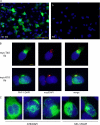Seeding of normal Tau by pathological Tau conformers drives pathogenesis of Alzheimer-like tangles
- PMID: 21372138
- PMCID: PMC3083182
- DOI: 10.1074/jbc.M110.209296
Seeding of normal Tau by pathological Tau conformers drives pathogenesis of Alzheimer-like tangles
Abstract
Neurofibrillary tangles (NFTs) in Alzheimer disease and related tauopathies are composed of insoluble hyperphosphorylated Tau protein, but the mechanisms underlying the conversion of highly soluble Tau into insoluble NFTs remain elusive. Here, we demonstrate that introduction of minute quantities of misfolded preformed Tau fibrils (Tau pffs) into Tau-expressing cells rapidly recruit large amounts of soluble Tau into filamentous inclusions resembling NFTs with unprecedented efficiency, suggesting a "seeding"-recruitment process as a highly plausible mechanism underlying NFT formation in vivo. Consistent with the emerging concept of prion-like transmissibility of disease-causing amyloidogenic proteins, we found that spontaneous uptake of Tau pffs into cells is likely mediated by endocytosis, suggesting a potential mechanism for the propagation of Tau lesions in tauopathy brains. Furthermore, sequestration of soluble Tau by pff-induced Tau aggregates attenuates microtubule overstabilization in Tau-expressing cells, supporting the hypothesis of a Tau loss-of-function toxicity in cells harboring NFTs. In summary, our study establishes a cellular system that robustly develops authentic NFT-like Tau aggregates, which provides mechanistic insights into NFT pathogenesis and a potential tool for identifying Tau-based therapeutics.
Figures

Similar articles
-
Synthetic tau fibrils mediate transmission of neurofibrillary tangles in a transgenic mouse model of Alzheimer's-like tauopathy.J Neurosci. 2013 Jan 16;33(3):1024-37. doi: 10.1523/JNEUROSCI.2642-12.2013. J Neurosci. 2013. PMID: 23325240 Free PMC article.
-
A seeding based cellular assay of tauopathy.Mol Neurodegener. 2016 Apr 26;11:32. doi: 10.1186/s13024-016-0100-9. Mol Neurodegener. 2016. PMID: 27112488 Free PMC article.
-
Tau Fibril Formation in Cultured Cells Compatible with a Mouse Model of Tauopathy.Int J Mol Sci. 2018 May 17;19(5):1497. doi: 10.3390/ijms19051497. Int J Mol Sci. 2018. PMID: 29772786 Free PMC article.
-
[Neuropathology of tauopathy].Brain Nerve. 2013 Dec;65(12):1445-58. Brain Nerve. 2013. PMID: 24323931 Review. Japanese.
-
[Significance of tau in the development of Alzheimer's disease].Brain Nerve. 2010 Jul;62(7):701-8. Brain Nerve. 2010. PMID: 20675874 Review. Japanese.
Cited by 224 articles
-
Paired Helical Filament-Forming Region of Tau (297-391) Influences Endogenous Tau Protein and Accumulates in Acidic Compartments in Human Neuronal Cells.J Mol Biol. 2020 Aug 7;432(17):4891-4907. doi: 10.1016/j.jmb.2020.05.027. Epub 2020 Jul 16. J Mol Biol. 2020. PMID: 32681841 Free PMC article.
-
FRET-based Tau seeding assay does not represent prion-like templated assembly of Tau filaments.Mol Neurodegener. 2020 Jul 16;15(1):39. doi: 10.1186/s13024-020-00389-1. Mol Neurodegener. 2020. PMID: 32677995 Free PMC article.
-
Prolonged tau clearance and stress vulnerability rescue by pharmacological activation of autophagy in tauopathy neurons.Nat Commun. 2020 Jun 26;11(1):3258. doi: 10.1038/s41467-020-16984-1. Nat Commun. 2020. PMID: 32591533 Free PMC article.
-
Role of dietary fatty acids in microglial polarization in Alzheimer's disease.J Neuroinflammation. 2020 Mar 24;17(1):93. doi: 10.1186/s12974-020-01742-3. J Neuroinflammation. 2020. PMID: 32209097 Free PMC article. Review.
-
Alzheimer's and Hyperglycemia: Role of the Insulin Signaling Pathway and GSK-3 Inhibition in Paving a Path to Dementia.Cureus. 2020 Feb 5;12(2):e6885. doi: 10.7759/cureus.6885. Cureus. 2020. PMID: 32190448 Free PMC article. Review.
Publication types
MeSH terms
Substances
LinkOut - more resources
-
Full Text Sources
-
Other Literature Sources
-
Medical
